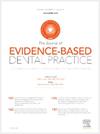ORAL HEALTH IMPACT AMONG CHILDREN: A SYSTEMATIC REVIEW UPDATE IN 2024
IF 4
4区 医学
Q1 DENTISTRY, ORAL SURGERY & MEDICINE
引用次数: 0
Abstract
Introduction
The project “Mapping Oral Disease Impact with a Common Metric” (MOM) characterizes the functional, pain-related, aesthetic, and broader psychosocial impacts of oral diseases and conditions using the 4 oral health-related quality of life (OHRQoL) dimensions: Oral Function, Orofacial Pain, Orofacial Appearance, and Psychosocial Impact. MOM's 4-dimensional oral health impact information in children was provided by Omara et al. in 2021. We aimed to update this information in 2024 by performing a new systematic review.
Methods
We performed a systematic review following PRISMA guidelines to identify original studies assessing the OHRQoL of children <18 years using the Oral Health Impact Profile (OHIP). OHIP publications were retrieved from 2 sources: (i) articles identified by Omara et al., 2021 (search date: 9 January 2019) and (ii) newly identified articles published from 2019 to 2024 in the following databases: Embase+Embase Classic (via Ovid), CINAHL, APA PsycINFO (via Ovid), Scopus, and Web of Science (Core Collection). Abstracts of 1128 articles were screened. The full-text of 199 articles was reviewed, and 24 articles were included. Their OHIP information was mapped into the 4-dimensional OHRQoL framework.
Results
Across 3 settings (general population subjects, dental patients, and medical patients) we identified 24 publications. They provided four-dimensional OHRQoL information for 49 populations in 55 samples (N = 8307 study participants). The Orofacial Appearance dimension had the highest impact, while the Psychosocial Impact dimension had the lowest. Functional impact scores were higher than pain-related impact scores. Among dental patients, those with anterior tooth extraction without replacement had the highest impact score within the Orofacial Appearance dimension.
Conclusion
Children's 4-dimensional oral health impact information in the “Mapping Oral Disease Impact with a Common Metric” (MOM) project was updated in 2024 with a systematic review. The findings for Oral Function, Orofacial Pain, Orofacial Appearance, and Psychosocial Impact in children are aligned with findings in adults using the same 4-dimensional impact measurements.
儿童口腔健康影响:2024年系统综述更新
“用一种通用度量方法绘制口腔疾病影响”(MOM)项目利用口腔健康相关生活质量(OHRQoL) 4个维度:口腔功能、口腔面部疼痛、口腔面部外观和社会心理影响,描述了口腔疾病和病症的功能、疼痛相关、美学和更广泛的社会心理影响。MOM对儿童口腔健康的四维影响信息由Omara等人于2021年提供。我们的目标是在2024年通过进行新的系统评价来更新这些信息。方法:我们按照PRISMA指南进行了一项系统综述,以确定使用口腔健康影响概况(OHIP)评估18岁儿童OHRQoL的原始研究。OHIP出版物从两个来源检索:(i) Omara et al., 2021年确定的文章(检索日期:2019年1月9日)和(ii) 2019年至2024年在以下数据库中发表的新确定的文章:Embase+Embase Classic(通过Ovid), CINAHL, APA PsycINFO(通过Ovid), Scopus和Web of Science(核心馆藏)。筛选了1128篇文章的摘要。全文199篇,收录24篇。他们的OHIP信息被映射到4维OHRQoL框架中。结果在3种情况下(普通人群、牙科患者和内科患者),我们确定了24篇出版物。他们提供了55个样本中49个人群(N = 8307名研究参与者)的四维OHRQoL信息。口腔面部外貌维度影响最大,而心理社会影响维度影响最小。功能影响评分高于疼痛相关影响评分。在牙科患者中,前牙拔牙不更换的患者在口腔面部外观维度上的影响评分最高。结论“口腔疾病影响测绘”(MOM)项目于2024年更新了儿童口腔健康的四维影响信息,并进行了系统评价。使用相同的四维影响测量,儿童的口腔功能、口面疼痛、口面外观和心理社会影响的研究结果与成人的研究结果一致。
本文章由计算机程序翻译,如有差异,请以英文原文为准。
求助全文
约1分钟内获得全文
求助全文
来源期刊

Journal of Evidence-Based Dental Practice
DENTISTRY, ORAL SURGERY & MEDICINE-
CiteScore
6.00
自引率
16.70%
发文量
105
审稿时长
28 days
期刊介绍:
The Journal of Evidence-Based Dental Practice presents timely original articles, as well as reviews of articles on the results and outcomes of clinical procedures and treatment. The Journal advocates the use or rejection of a procedure based on solid, clinical evidence found in literature. The Journal''s dynamic operating principles are explicitness in process and objectives, publication of the highest-quality reviews and original articles, and an emphasis on objectivity.
 求助内容:
求助内容: 应助结果提醒方式:
应助结果提醒方式:


